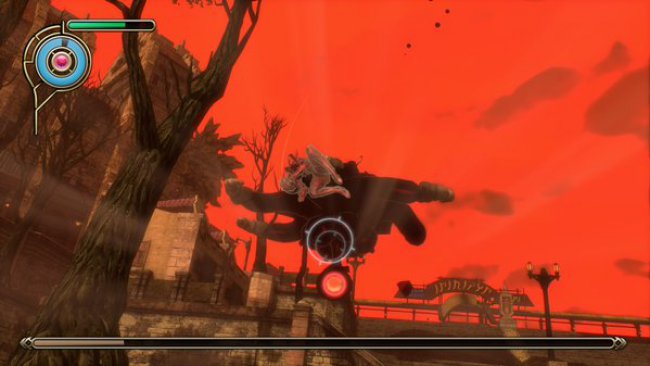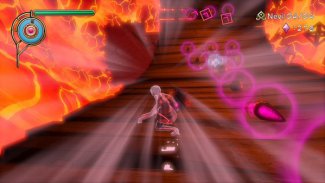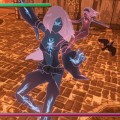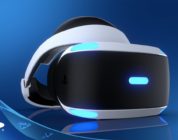The apple doesn’t fall too far from the tree. Even though PlayStation 4 is a lot more powerful than the Vita can ever hope to be, the remaster crew at Bluepoint Games have decided to stay as true to the original Gravity Rush as possible. That means the game shows signs of aging, but still contains all the creativity that enthralled Vita owners back in 2012.
To fly above a city seldom feels as good as it does in Gravity Rush. Maybe that’s because Kat never flies, she falls with style. With a tap on R1 you make yourself weightless and with another press you choose which way gravity should push you. There is a satisfying weight behind Kat as she moves through the skies, emphasised by the barrels and screaming citizens you often push with you. There are few open-world games where it feels this good to move around. It’s also a testament to the quality of the camera, how rarely you get confused while flying around with Kat. It does happen that you lose sight of what’s up and down, but that’s part of the charm. You can choose to control the camera either with the analogue or by tilting the controller back and forth, which here feels like a poorly implemented gimmick (a gimmick you’re thankfully never forced to employ). If you thought fighting could become overwhelming in the original game then try fighting while swinging the controller above your head.

The battle system gives the same satisfying feeling as when you’re soaring high above the city. Pressing square, the gravity will push you harder while you’re aiming at the opponent’s weak spot. Flying towards the enemy and smashing into them while they crumble under your feet is fun from beginning to end. It does work best when the screen is not overpopulated with enemies, because the battle system is designed to have you focus on one enemy at the time. This can cause frustration near the end, when they raise the challenge by sending a larger number of enemies after you. The game works best when you have an overview, which is easy to lose when you can’t keep track of all your opponents. That being said, it was a bigger problem on the Vita, as the small screen made it harder to see all the threats around you. Playing on PlayStation 4, the bigger screen does make it easier to have an overview of proceedings.
In other places it hasn’t helped the game to be transferred to console. While to this day it is still is an impressive piece of work for a Vita game, the world never manages to live up to the expectations you have for a PlayStation 4 title. The city is brown and colourless, only inhabited by a handful of people here and there, all with as much personality as the benches they’re sitting on. It is possible to talk to some of them, but the conversation often leaves you with a puzzled expression. Why was it necessary to know that the view is especially good right here? The city lacks life and it’s a shame, because the gameplay makes you want to explore, but you don’t feel like there is anything much to see. Even the times you leave the city on different missions, the brown colour palette is just tweaked with a dash of yellow or white.
When you play an open-world game from Ubisoft, the map is often overpopulated with side-missions and collectibles (something that’s increasingly referred to as Ubisoftication). In contrast to that the map in Gravity Rush is embarrassingly naked. There are challenge missions, where you either have to complete a race, defeat a bunch of enemies, or transport citizens away from danger. There are leaderboards, so you can compete with your friends, but it’s unlikely that this will keep you entertained for too long. All three DLC packs are included in the game, but they rarely provide anything new or refreshing to the experience. In particular The Diary of the Maid feels like filler when you’re asked to clean up by carrying vases from the front lawn to the back lawn. It’s times like these when we think to ourselves: “We might as well clean up our own house.” The military mission does offer a little character development to a side character, but generally the side-missions are only worth it if you want to collect all the costumes for Kat.

Regarding character development, and the story in general: this is something Japan Studio could have spent a little more time with. As seen so often in Japanese games, the protagonist wakes up with amnesia. She has no idea who she is, how she got there and how she got her powers. Questions the game doesn’t seem eager to explore, except for a few vague possible explanations. Additionally she looks like the classic Japanese protagonist by having a pure heart and only wanting what’s best for the people. She does have a certain vanity to her, that starts out being interesting – more because it’s a character trait you don’t see often – but quickly even this turns tedious. When her main motivation for helping others is her wish to finally find a boyfriend, then the immersion breaks completely. Women in fiction whose main goal is to have a boyfriend never seem credible, and it’s more like a man’s naïve picture of a woman. The story also runs along without surprises and ends on a pretty unsatisfying note. But it does manage to push you towards the next battle and that is what’s most important. In Gravity Rush you come for the gameplay, and you stay for the gameplay.
All the magic from the Vita version is still here in this remaster, however the bigger screen just makes it harder to look away from the mistakes. Regardless of the game’s shortcomings, it’s still worth playing for everything it does well (which is a lot). It’s noticeable that it’s originally a Vita game, because your powerful console never seems to break a sweat, but the creativity is still there. And this is the perfect appetizer for what will hopefully be a spectacular main course. If this is what Japan Studio managed to push out of the Vita, we can only dream about what they’ll manage to do with Gravity Rush 2 on PlayStation 4. This is a formidable game, which does show signs of aging, but deserves to be played, by newcomers and veterans alike.






